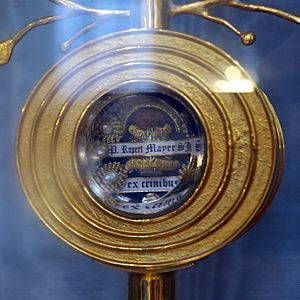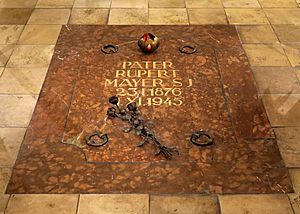Rupert Mayer facts for kids
Quick facts for kids Blessed Rupert Mayer, SJ |
|
|---|---|
 |
|
| The Apostle of Munich | |
| Born | 23 January 1876 Stuttgart, Germany |
| Died | 1 November 1945 (aged 69) Munich, Germany |
| Venerated in | Roman Catholic Church |
| Beatified | 3 May 1987, Munich by Pope John Paul II |
| Feast | 3 November |
Rupert Mayer, S.J. (born January 23, 1876 – died November 1, 1945) was a German Jesuit priest. A Jesuit is a member of a religious order in the Catholic Church. He became a very important leader in the Catholic Church who stood up against the Nazis in Munich, Germany. In 1987, he was declared "Blessed" by Pope John Paul II. This means the Catholic Church recognized his holy life.
Contents
Who Was Rupert Mayer? His Early Life
Rupert Mayer was born in Stuttgart, Germany. He grew up with four brothers and sisters. After finishing high school in 1894, he studied philosophy and theology. These are subjects about deep ideas and religious beliefs. He studied in cities like Freiburg, Munich, and Tübingen.
In 1899, he became a priest. For a year, he worked as an assistant pastor. Then, in 1900, he joined the Society of Jesus in Feldkirch, Austria. After more studies in the Netherlands, he traveled around Germany, Switzerland, and the Netherlands. He preached in many churches. In 1912, he moved to Munich. There, he helped many people who had moved to the city looking for work.
Rupert Mayer: A Brave Army Chaplain

When World War I started in 1914, Father Mayer volunteered to be a chaplain for the army. A chaplain is a priest who serves in the military. First, he worked in a military hospital. Later, he became a Field Captain. He was sent to the front lines in France, Poland, and Romania. He served as a chaplain for a division of soldiers.
Father Mayer was known for his bravery. Soldiers respected him greatly. During battles, he would crawl on the ground to reach soldiers. He talked to them and gave them spiritual support. In December 1915, he was the first chaplain to receive the Iron Cross. This award was for his bravery and work with soldiers. In December 1916, he was hurt in a grenade attack and lost his left leg. He returned to Munich to get better. People then called him the "Limping Priest."
After the war, Father Mayer continued his work. He managed a religious retreat and preached. From 1921, he led a group for men in Munich. He even started Sunday Masses at the main train station. This made it easier for travelers to attend church.
Standing Up to the Nazis
In January 1933, Adolf Hitler became the leader of Germany. His government, the Nazis, began to close church schools. They also tried to make religious groups look bad. Father Mayer spoke out against these actions. He preached from the pulpit of St. Michael's in Munich. He was a powerful voice in the city. The Nazis did not like anyone who opposed them.
On May 16, 1937, the Gestapo, Hitler's secret police, told Father Mayer to stop speaking in public. He obeyed this order, but he kept preaching in church. He spoke against the Nazis' attacks on Catholics. He believed that a Catholic could not support the Nazi party. He famously preached, "Man must obey God more than men."
His protests led to him being arrested many times. He was sent to Landsberg prison. Father Mayer bravely spoke out against the Nazis' evil actions in his talks and sermons. On June 5, 1937, he was arrested again. He was held in "protective custody" for six weeks. When the Nazis spread lies about him, his Jesuit leaders allowed him to preach again. He defended himself against their false claims. He was arrested again and spent five months in prison.
On November 3, 1939, Father Mayer was arrested once more. He was sent to Sachsenhausen concentration camp. This was because of old laws that stopped clergy from making political statements. The 63-year-old priest developed heart problems there. In late 1944, the Nazis moved him to Ettal Monastery. They were afraid he would die in the camp and become a hero. He stayed there until American soldiers freed him in May 1945.
An American officer brought him back to Munich. Father Mayer went back to his duties at St. Michael's Church. He died on November 1, 1945, while celebrating Mass. He had a stroke during the 8:00 AM Mass on All Saints' Day. Thousands of people attended his funeral. He was first buried in Pullach. Because so many people visited his grave, his remains were moved in 1948. He was reburied in the Bürgersaalkirche in Munich.
Honoring Rupert Mayer

After his death in 1945, many people wanted Father Mayer to be declared "Blessed." In 1950, Cardinal Michael von Faulhaber began the official process. In 1951, the Jesuit leader Otto Faller sent the information to Rome.
In 1956, Pope Pius XII gave Father Rupert Mayer the title "Servant of God." This Pope had known Father Mayer personally. Later, Pope John XXIII started the process for beatification. The results were accepted by Pope Paul VI in 1971. In 1983, Pope John Paul II declared his virtues "heroic." Finally, Pope John Paul II declared him "Blessed" on May 3, 1987, in Munich. His feast day is celebrated on November 3.
A chapel at Fordham University in New York is named after Rupert Mayer.
Rupert Mayer's Legacy and Impact
Father Mayer's memory lives on in many ways. In Bavaria, Germany, many streets are named after him. In 1954, a group called the Cartell Rupert Mayer (CRM) was started. This group continued the work of an earlier Christian group founded in 1946.
In Pullach, Bavaria, a public school and two types of high schools (a Realschule and a Gymnasium) are named after him. In the Philippines, several Jesuit schools have sections named after him. These include Sacred Heart School – Ateneo de Cebu, Xavier University – Ateneo de Cagayan, and Ateneo de Davao University Senior High School. Regis Jesuit High School in Colorado, USA, also has a chapel dedicated to him. In 2006, Fordham University in New York named a chapel after him. There is also a missionary school named after him in Zimbabwe.
In 1988, Father Rupert Mayer was featured on a German postage stamp. He was honored alongside Edith Stein for their beatifications. In 2014, a movie about his life called "Father Rupert Mayer" was made. You can watch the movie on YouTube.
A Prayer by Rupert Mayer
Here is a prayer that comes from a song by the Bukas Palad Music Ministry:
Lord, what You will let it be so
Where You will there we will go
What is Your will help us to know
Lord, when You will the time is right
In You there's joy in strife
For Your will I'll give my life
To ease Your burden brings no pain
To forego all for You is gain
As long as I in You remain
REFRAIN:
Because You will it, it is best
Because You will it, we are blest
Till in Your hands our hearts find rest
Till in Your hands our hearts find rest
Images for kids
See also
 In Spanish: Rupert Mayer para niños
In Spanish: Rupert Mayer para niños






